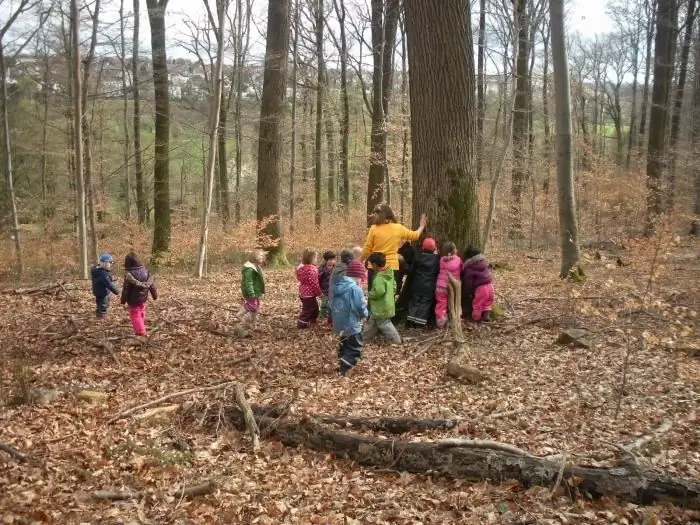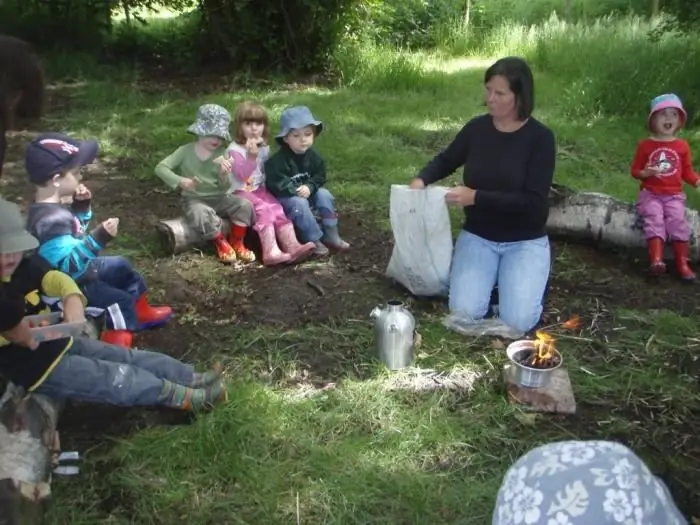- Author Harold Hamphrey [email protected].
- Public 2023-12-17 10:06.
- Last modified 2025-01-24 11:10.
Walking through the forest for a city dweller is a rare opportunity to relax in the fresh air from the city's hustle and bustle. The soft rustle of leaves, the many-voiced chirping of birds, the businesslike hum of insects… All this is like another world. A world filled with the aromas of greenery and flowers, a world living its own life, unfamiliar to the townspeople. To make your vacation in the forest leave only pleasant memories, you must follow the basic safety rules and know how to behave in the forest.

Getting ready for a walk
Before you go to the forest, brush up on your school knowledge of orienteering. Remind yourself how the sun moves, which side moss grows on, how anthills are built. Get a compass and learn how to use it. Remember how to build a fire. Of course, protecting forests from fires is important, but in some situations, fire is necessary.
For a trip to the forest, choose clothes and shoes suitable for the weather. They should be comfortable, tight-fitting, preferably waterproof. Treat your suit with insect repellent immediately before you travel to protect yourself from insect bites.
It is best to go to the forest with a company. Of course, it is not necessary to assemble a huge team, but it is also undesirable to go alone. When will youin the forest, try to stay within sight of each other, call to each other.
One of the relatives, acquaintances, colleagues must be informed about the proposed route and time of the trip. There must be someone in the city who will know when you planned to return and where to look for you in case of an unforeseen delay.
Your belongings should include a mobile phone with a fully charged battery, a watch, a knife, a compass, food and water. Even if you do not smoke and do not intend to make a fire, be sure to take matches with you, wrapping them in plastic. Pack a first aid kit with you. It should include:

- medication you need if you have a chronic condition;
- dressing package (cotton wool, bandage, adhesive plaster);
- twist to stop bleeding;
- an antiseptic for treating wounds (such as hydrogen peroxide or ethyl alcohol);
- anesthetic (novocaine or others);
- iodine or brilliant green;
- analgesic;
- ammonia;
- activated carbon;
- surgical set of needle and thread.
Also, take a trash bag with you. Knowing how to behave in the forest includes the ability to protect the purity of nature.
But alcoholic drinks should be excluded from the set of things. Their use reduces concentration, and a pleasant walk can end sadly.
If children are traveling with you, explain to them in detail how to behave in the forest. Tell that the forest needs to be protected, with respecttreat its inhabitants. The child must understand that no matter how friendly the forest may seem, it is dangerous to move away from you. And yet, being in the forest, constantly watch the baby: flowers, butterflies, berries and mushrooms can captivate him, and he will forget about your instructions.

Forest walk
Before you enter the forest, carefully look at the sun. Pay attention to its location: where it is now and where it should be when you return. This will help you navigate much better than trying to memorize every tree and bush on your way.
Our forests are not rich in deadly mushrooms and berries. And yet there are such types. Therefore, never collect and do not eat in any case unknown to you forest gifts. However, there is no need to destroy them. What is unacceptable to you may be vital to the animals living in the forest.
If you're in the woods long enough or staying overnight, keep a close eye on ticks. Remember that these dangerous insects prefer secluded places to bite (groin, armpits, neck, knees and elbows), stomach. Even if your walk was very short, carefully look around when you return.
If you do get lost, don't panic. Look around carefully, trying to understand where the sun is, from which side you came. Call 112 from your mobile phone to rescuers. This number can be dialed even with a negative balance and a locked keypad. Explain to the operator what happened, where and whenyou entered the forest. Tell in detail what surrounds you now (river, lake, swamp, power line, etc.). Remain calm and follow the instructions given by the operator exactly. Remember that your life depends on your calmness and fidelity of actions.
Of course, a rare walk out of town ends in such trouble. But you need to be prepared for any surprises. If you know how to behave in the forest, it will help you get only positive emotions from communicating with nature.






